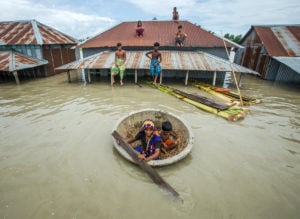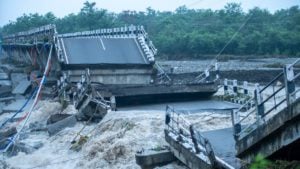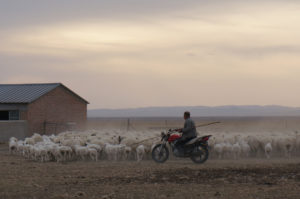Mountainous regions such as the Hindu Kush Himalayas are facing severe consequences from climate change. Scientists are calling for more attention to be paid to the region, as COP28’s climate negotiations get underway in Dubai.
A new report by the International Cryosphere Climate Initiative (ICCI) warns of severe consequences for millions – as well as irreversible damage to glacial areas – if the global average temperature rise reaches two degrees Celsius. This represents the upper temperature limit agreed upon under the Paris Agreement. New developments in cryosphere research have led the report’s authors to declare that the Paris Agreement’s goal is outdated: “1.5C is the only option”.
Beyond 2C, the report says Earth will experience “catastrophic loss” of mountain glaciers and snow, sea ice, and permafrost. Notably, it was published just a day before the global average temperature exceeded pre-industrial levels by 2C for the first time in history, on 17 November.
The Paris Agreement is a landmark international agreement which aims to limit global average temperature rise to “well below 2 degrees Celsius above pre-industrial levels”, and to ‘pursue efforts’ to limit warming to 1.5C. The Agreement was finalised in 2015, and has been signed and ratified by almost every country in the world.
Under the Paris Agreement, countries present plans to reduce emissions and adapt to the effects of climate change (known as Nationally Determined Contributions or NDCs), and are supposed to review these commitments every five years. The agreement also covers provision of financial support to developing countries to deal with the impacts of climate change, and management of global carbon markets.
The Hindu Kush Himalayas (HKH) in particular will be badly affected, the report notes. “While a world that is 2C or more warm will be catastrophic for almost all regions, nowhere will its effect be more felt than in the HKH,” Aditi Mukherji tells The Third Pole. A coordinating lead author of the “Water” chapter of the Intergovernmental Panel on Climate Change’s (IPCC) most recent Assessment Report, Mukherji says “this will mean a near-complete loss of ice, snow, and glaciers” in the HKH.
In parallel to the ICCI report’s launch, scientists launched the “Cryosphere Call to Action” campaign, which chiefly urges global leaders to redefine the Paris Agreement’s “upper” limit from “well below 2C” to strictly 1.5C. It then calls for a stocktake to achieve that goal, as well as a plan to phase out fossil fuels.
“Irreversible loss about to be locked in”
Breaching 2C for an extended period would mean the irreversible loss of glaciers from a number of major river basins, the ICCI report notes. Glacial melt can lead to more frequent catastrophic events such as landslides and glacial lake outburst floods. “The heavily populated HKH and the ten basins of the Himalayan rivers will face drastic hydrographic changes in such a scenario of global warming,” says Jayanta Bandyopadhyay, a distinguished fellow at the Observer Research Foundation.
Global warming is already bringing severe impacts to the HKH region’s large population, according to Pema Gyamtsho, director general of the International Centre for Integrated Mountain Development (ICIMOD) and one of the authors of the report’s foreword. “These changes are upending the lives of mountain communities by increasing uncertainty in the timing, availability, and seasonal distribution of mountain water resources, threatening water, food, and energy security,” he said at the report’s launch event. “The report is a warning to global leaders that inaction at COP28 will be disastrous.”
Earlier this year, researchers at ICIMOD found that glaciers in the Hindu Kush Himalayas disappeared “65% faster in the 2010s than in the previous decade”. They predict that with current global greenhouse gas emissions, four-fifths of current glacier volume will disappear by 2100. As a result, “availability of water is expected to peak in mid-century and then decline,” while floods and landslides are projected to increase.
“The total and irreversible loss of mountain glaciers around the world is about to be locked in unless immediate action is taken,” said James Kirkham, chief scientific adviser to the ICCI, at a recent ICIMOD meeting in Kathmandu.
The ICIMOD report highlights that mountain communities are already experiencing crop failure and loss, livestock deaths, infrastructure damage from disasters, and the loss of traditional livelihoods. This is causing an exodus of people to urban areas. All of this will increase due to extreme weather events.
Climate change will impact upon most ecosystems, including the unique plants and animals of the Himalayas. The report warns of habitat loss affecting the wild yak, snow leopard and Asian black bear, for instance, and says that amphibian species such as the Himalaya and Kashmir paa frogs will become extinct without immediate action to mitigate global warming.
The impacts of these changes are felt far beyond the mountains themselves. As mountain glaciers melt due to temperature increases, glacial runoff enters the ocean, leading to a rise in sea levels. This “global ice emergency” will mean that parts of Dhaka, Karachi and Mumbai will be underwater by 2050, Kirkham said.
We are talking about the lives of millions of people who have had minimal carbon footprints themselves and yet are being disproportionately affected by climate changeAditi Mukherji, Intergovernmental Panel on Climate Change (IPCC) hydrology expert
The Third Pole speaks to Anjal Prakash, research director at the Bharti Institute of Public Policy: “Inaction puts the foundation of mountain communities at risk. It initiates a worldwide emergency, bringing a future that will also impact megacities along the coast that will be submerged due to glacial melt, on top of sea level rise.” Prakash was also a coordinating lead author of the “Mountains” chapter in the latest IPCC report.
Within mountain regions, climate impacts and increases in weather extremes may cause poorly planned infrastructure projects to fail, endangering local populations – with the landslide-induced tunnel collapse in Uttarakhand last month being the latest example.
Disasters like the catastrophic 2022 floods in Pakistan “exemplify the impact of weather extremes in South Asia that have led to adverse effects on ecosystems, people, livelihoods, assets, and infrastructure,” says Ajaya Dixit, a research adviser at the Institute for Social and Environmental Transition in Nepal. Dixit, who is also a visiting professor in water resource and climate change at Kathmandu School of Law, adds: “The 2021 Chamoli disasters in Uttarakhand, the 2021 Melamchi disaster in Nepal, and 2023 dam failure in Sikkim serve as illustrations of the inadequacy of the current engineering design approach in addressing emerging climate risks in mountain regions.”
The ICCI report notes that “only a strong, emergency-scale course-correction towards 1.5C can avert higher temperatures, to slow and eventually halt these cryosphere impacts within adaptable levels.”
Not enough attention given to mountainous regions
Many researchers and NGOs working in the Hindu Kush Himalayas believe mountains do not get the attention they deserve at global climate negotiations. “We are talking about the lives of millions of people who have had minimal carbon footprints themselves and yet are being disproportionately affected by climate change,” says Mukherji. “Hopefully, COP28 will see the operationalisation of the loss and damage fund, and regions such as the Hindu Kush Himalayas will be prioritised.”
Additionally, climate reports such as those produced by the IPCC have historically featured poor representation of scientists from developing countries. In November The Third Pole interviewed the Nepali atmospheric scientist Maheswar Rupakheti. He is the first Nepali scientist to ever be elected to the IPCC bureau. Rupakheti said Anglocentrism had led to less literature from many countries – including those of the HKH – being utilised in reports and decisions: “Despite being at the forefront of [climate change] impacts, the Himalayas haven’t received the attention they need globally.”
Bandyopadhyay says the devastating consequences of glacial melt “must be the reason for COP28 to wake up and take strong and legally binding resolutions to prevent future disasters.” He notes that all the countries of the Hindu Kush Himalayas need to negotiate jointly for this to happen.








